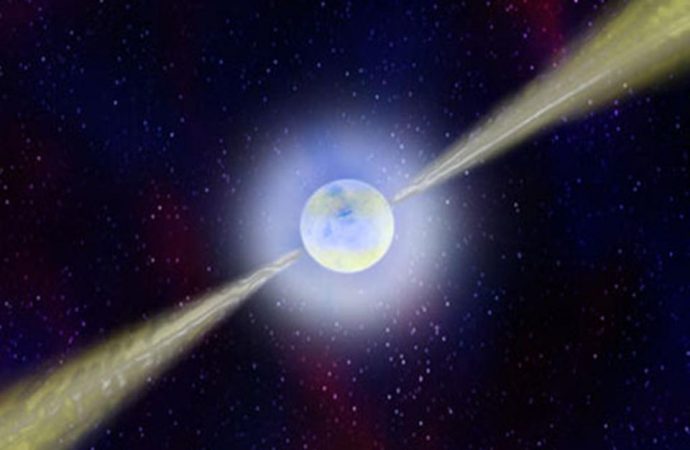Behold: the most powerful searchlights in the universe.
Source: Forbes
So in the middle of the 20th century, after we first invented radio telescopes, we found all sorts of surprises. It turns out that the universe is pretty loud, full of all kinds of interesting radio sources. Some of them were familiar, and some of them were quite odd. As you can imagine, it was a pretty exciting time to be a radio astronomer.
Out in the middle of the English countryside, two particularly excited people were Antony Hewish and his grad student Jocelyn Bell Burnell. They were hunting for quasars, relatively new characters on the astronomical scene, which were at the very at the time poorly understood. All we knew then is that they were very loud radio sources and very far away.
In their hunt for quasars they instead found something absolutely remarkable and unprecedented in the history of astronomy: they found a single source in the sky that flashed. Perfectly. Every 1.33 seconds. This source, whatever it was, pulsed a burst of radio energy. And then turned off. And then did it again, exactly 1.33 seconds later
It was astounding. How could something in nature produce something so regular and periodic?
Hewish and Burnell didn’t really believe that they had found evidence for an extraterrestrial alien civilization, but you never know, right? As an “inside joke” within the community they dubbed this source LGM-1. That stands for Little Green Men (and the first such one to be encountered).
Whatever it was, there was a lot of excitement around it. But once another similar source was discovered on the opposite side of the sky, and then another, and then another, and then another, astronomers sadly put away the LGM moniker. They got a new name: pulsars, short for pulsating quasar. It turns out that pulsars have absolutely nothing to do with quasars, but you can’t fault astronomers in the 1960s for not really knowing what was going on. Especially after coming off the high of potentially finding alien life.
The theoretically minded folks in the community quickly devised a solution to explain their behavior. They had known for some time of a hypothetical object called a neutron star, formed when a massive star dies and compresses its core down to crushing extremes. At the time they were just hypothetical objects, but the pulsar provided a way to test if they were real.
Because of their extreme gravity coupled with extreme electric and magnetic fields, these neutron stars could rotate up to incredible speeds and shoot out jets of radiation from their poles. These jets sweep around like a lighthouse, with the Earth sometimes getting caught in the blast. From our perspective we won’t see the beam all the time, just a brief flash as the it washes over us.
A pulsar.
One of the most extreme, exotic objects in the known universe. Second only to – and perhaps exceeding – the strangeness of black holes themselves. The odd, repeating signal Burnell and Hewitt found in the 1960s wasn’t an alien, but it just might be more fascinating after all.

































Leave a Comment
You must be logged in to post a comment.